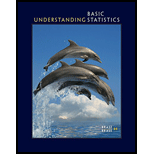
Concept explainers
Expand Your Knowledge: Plus Four Confidence Interval for a Single Proportion One of the technical difficulties that arises in the computation of confidence intervals for a single proportion is that the exact formula for the maximal margin of error requires knowledge of the population proportion of success p. Since p is usually not known, we use the sample estimate p = r/n in place of p As discussed in the article "How Much Confidence Should You Have in Binomial Confidence Intervals?"appearing in issue no, 45 of the magazine STATS (a publicationof the American Statistical Association), use of p as an estimate for p means that the actual confidence level for the intervals may in fact he smaller than the specified level c. This problem arises even when n is large, especially if p is not near 1/2.
A simple adjustment to the formula for the confidence intervals is the plus estimate, first suggested by Edwin Bidwell Wilson in 1927. It is also called the Agresti-Coull confidence interval. This adjustment works best for 95% confidence intervals
The plus four adjustment has us add two successes and two failures to the sample data. This means that r, the number of successes, is increased by 2, and n, the
(a) Consider a random sample of 50 trials with 20 successes. Compute a 95% confidence interval for p using the plus four method (b) Compute a traditional 95% confidence interval for p using a random sample of 50 trials with 20 successes.
(c) Compare the lengths of the intervals obtained using the two methods. Is the point estimate closer to 1/2 when using the plus four method? Is the margin of error smaller when using the plus four method?
(a)
To find: The95% confidence interval for p using the plus four method.
Answer to Problem 28P
Solution:
The 95% confidence interval for
Explanation of Solution
Calculation:
Let r be a random variable that represents the number of successes out of the n binomial trials.
The plus four point estimates for p and q are,
We have to find 95% confidence interval,
95% confidence interval is
The 95% confidence interval for
Margin of error is
(b)
To find: Thetraditional95% confidence interval for p using the plus four method.
Answer to Problem 28P
Solution:
The 95% confidence interval for
Explanation of Solution
Calculation:
Let r be a random variable that represents the number of successes out of the n binomial trials.
We estimate p, q by the sample point estimates:
We have to find 95% confidence interval,
90% confidence interval is
The 95% confidence interval for
Margin of error is
(c)
To explain: Whether the point estimate is closer to
Answer to Problem 28P
Solution: Yes, the point estimate is closer to
Explanation of Solution
Since the95% confidence interval for p using the plus four method is (0.28, 0.54) and the95% confidence interval for p using a traditional method is (0.26, 0.54). The length of confidence interval using the plus four method is 0.26 and for traditional method it is 0.28. Hence, the length of the confidence interval using plus four method is slightly smaller than traditional method because the sample size is increased by 4 in plus four method.
The point estimate when using the plus four method is 0.41 which is nearly closer to
The margin of error is smaller when we used the plus four method because the sample size is increased by 4 in plus four method.
Want to see more full solutions like this?
Chapter 8 Solutions
Understanding Basic Statistics
- At the same restaurant as in Question 19 with the same normal distribution, what's the chance of it taking no more than 15 minutes to get service?arrow_forwardClint, obviously not in college, sleeps an average of 8 hours per night with a standard deviation of 15 minutes. What's the chance of him sleeping between 7.5 and 8.5 hours on any given night? 0-(7-0) 200 91109s and doiw $20 (8-0) mol 8520 slang $199 galbrog seam side pide & D (newid se od poyesvig as PELEO PER AFTE editiw noudab temand van Czarrow_forwardTimes to complete a statistics exam have a normal distribution with a mean of 40 minutes and standard deviation of 6 minutes. Deshawn's time comes in at the 90th percentile. What percentage of the students are still working on their exams when Deshawn leaves?arrow_forward
- Suppose that the weights of cereal boxes have a normal distribution with a mean of 20 ounces and standard deviation of half an ounce. A box that has a standard score of o weighs how much? syed by ilog ni 21arrow_forwardBob scores 80 on both his math exam (which has a mean of 70 and standard deviation of 10) and his English exam (which has a mean of 85 and standard deviation of 5). Find and interpret Bob's Z-scores on both exams to let him know which exam (if either) he did bet- ter on. Don't, however, let his parents know; let them think he's just as good at both subjects. algas 70) sering digarrow_forwardSue's math class exam has a mean of 70 with a standard deviation of 5. Her standard score is-2. What's her original exam score?arrow_forward
- Clint sleeps an average of 8 hours per night with a standard deviation of 15 minutes. What's the chance he will sleep less than 7.5 hours tonight? nut bow visarrow_forwardSuppose that your score on an exam is directly at the mean. What's your standard score?arrow_forwardOne state's annual rainfall has a normal dis- tribution with a mean of 100 inches and standard deviation of 25 inches. Suppose that corn grows best when the annual rainfall is between 100 and 150 inches. What's the chance of achieving this amount of rainfall? wved now of sociarrow_forward
 Glencoe Algebra 1, Student Edition, 9780079039897...AlgebraISBN:9780079039897Author:CarterPublisher:McGraw Hill
Glencoe Algebra 1, Student Edition, 9780079039897...AlgebraISBN:9780079039897Author:CarterPublisher:McGraw Hill
